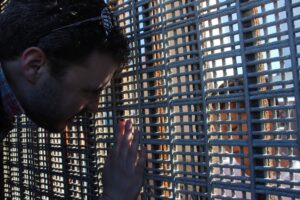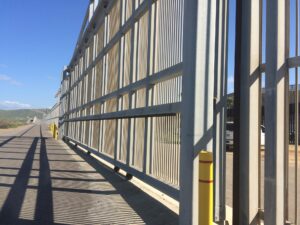Our trip to the US/Mexico wall

This past weekend, the staff and steering committee of the US Campaign for Palestinian Rights held one of our biannual in-person meetings in San Diego, California. We gathered in the southwest corner of the United States to review strategic and programmatic planning for the year and beyond. While we had chosen the location of this meeting last summer, being in San Diego at this particular moment turned out to be especially important.
As we discussed how to advance the agenda for Palestinian rights, members of immigrant communities near and far were fearing and resisting a rash of Immigration and Customs Enforcement (ICE) raids launched that very weekend. We were reminded that even as we work for the rights of Palestinians who are abused, divided and oppressed by the machinations of Israeli government policy 10,000 miles away, there were families — some even blocks away — who were bracing for the possibility that state agents may burst into their homes in the middle of the night and forcibly separate parents from their children.
For months, we had planned to take the short ride from San Diego down to the US/Mexico border to meet and learn from human rights activists focused on immigrant rights and see for ourselves what is happening at the border. There, through a thick iron mesh wall, we watched as mothers on the Mexican side prayed to be reunited with their daughters and as family members divided by this metallic monstrosity sat next to each other on opposite sides, cherishing the limited moments they had together before border patrol agents slammed shut the doors to the visitation area. As we watched these scenes before us, we could not help but feel we had seen them before and for some among us we could not help but recognize we had lived them before.
All of this came amidst the heightened, hateful, political rhetoric that characterized Trump’s presidential campaign and was quickly put into practice in recent weeks. Days after our trip to the border wall, Israeli Prime Minister Benjamin Netanyahu would be meeting with President Trump in the White House. Netanyahu, who has made a career out of using fear to justify the imposition of abusive security policies, has lent enthusiastic support to Trump even as much of the world was appalled at orders to build bigger walls and ban Syrian refugees and many Muslim immigrants. In turn, Trump pointed to Israel’s walls, which carve up Palestinian land and deny entry to refugees, as justification for his own policies.

Policy Director Josh Ruebner connects with a young boy across the iron mesh wall on the US/Mexico border.
While the situations are unique, the parallels are undeniable. Seeing the situation at the border with our own eyes was an important reminder of the urgent need to recognize the connectivity between people around the world whose dignity and humanity are threatened by state violence. Likewise, it is important to recognize the connectivity between those state agents of violence. While Trump and Netanyahu mutually reinforce each other’s policies, the Israeli company Elbit systems manages technology for both the US and Israeli walls, and Magal, the Israeli company which helped encage Gaza and build an illegal wall in the West Bank, is bidding on contracts to build an even bigger wall on the US/Mexico border. That project is reportedly going to cost US taxpayers over $20 billion — no wonder Magal’s stock has seen an unprecedented 62% increase in value since election day.
As we march on with our work for Palestinian rights, we do so with a redoubled focus on the connectivity between systems of oppression and the connectivity between those resisting oppression. Help us continue our work through this intersectional approach. We encourage others to join us as we continue to investigate these connected systems to sharpen our analysis and commitment to each other and collective liberation.
P.S. Check out these important resources to learn more about what is happening and how we can support and protect one another:
- Community Defense Zone starter kit from Mijente
- Sanctuary Toolkit from SantuaryDMV: Sanctuary Not Deportation and People’s Assembly toolkits on how to prepare and organize in your area
- If An Agent Knocks Center for Constitutional Rights booklet on what to do if you or your organization are targeted by federal law enforcement
- Know Your Rights deportation defense cards in five languages from United We Dream
- Great resources DRUM South Asian Organizing Center, plus their guide for sharing reports of raids on social media responsibly
- Immigrant Rights issue analysis and resources from member group American Friends Service Committee, which guided our US Campaign trip to the wall
P.P.S. Click here to see and share more photos from our trip to the wall.
